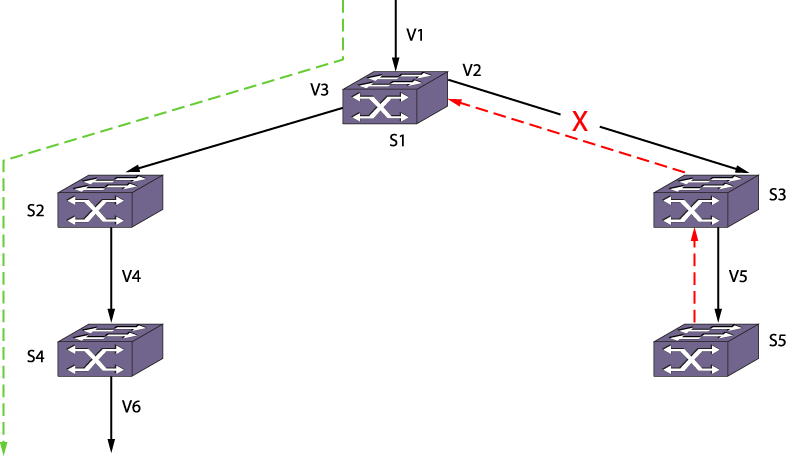PIM-DM is a broadcast and prune protocol, which means that multicast servers initially broadcast traffic to all destinations, and then switches later prune paths on which there are no receivers. PIM-DM Operation shows a dense mode multicast tree with an active branch and a pruned branch.

Multicast traffic is flowing from VLAN (Virtual LAN) V1 connected to switch S1. S1 floods multicast traffic to both neighbors S2 and S3 which in turn flood multicast traffic to S4 and S5. S4 has IGMP (Internet Group Management Protocol) members, so it floods multicast traffic down to VLAN V6. S5, which has no multicast members, sends a prune upstream towards the source. The green line shows the flow of traffic on the active branch, and the red line shows the prune sent upstream for the pruned branch. After outgoing interface V2 is pruned from the multicast tree, subsequent multicast traffic from S1 flows only through S2 and S4 and is not forwarded to S3.
After S3 sends a prune upstream, S3 starts a prune hold time timer on outgoing interface V5. When this timer expires, S3 adds V5 back to the multicast egress list and sends a graft upstream to pull multicast traffic down again. When multicast traffic arrives from S1, it is forwarded to S5, which repeats the upstream prune message because it still has no members. This prune, time-out, and flood process repeats as long as the traffic flow exists and no members are on the pruned branch, and this process consumes bandwidth during every cycle.

Note
This feature is supported at and above the license level listed for this feature in the license tables in the ExtremeXOS 22.3 Feature License Requirements document.PIM-DM routers perform reverse path multicasting (RPM). However, instead of exchanging its own unicast route tables for the RPM algorithm, PIM-DM uses the existing unicast routing table for the reverse path. As a result, PIM-DM requires less system memory.

 Print
this page
Print
this page Email this topic
Email this topic Feedback
Feedback